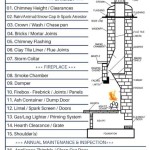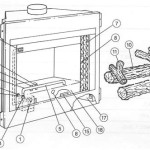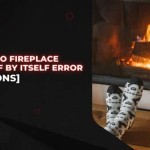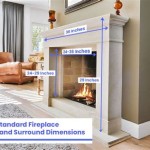Brick Fireplace Makeover: A Guide to Painting for a Modern Update
A brick fireplace, once a charming focal point, can sometimes appear dated or clash with a new interior design scheme. Painting a brick fireplace offers a relatively straightforward and cost-effective solution to modernize its appearance and integrate it seamlessly into the overall aesthetic of a room. This article provides a comprehensive guide to painting a brick fireplace, covering preparation, paint selection, application techniques, and essential safety considerations. The information presented aims to equip homeowners with the knowledge necessary to achieve a professional-looking result.
Before undertaking a brick fireplace painting project, it is crucial to understand the potential impact on the character of the brick. Painting brick is a relatively permanent alteration, and removing paint can be difficult and time-consuming. Consider the long-term implications and ensure painting aligns with the desired aesthetic before proceeding. Alternatively, explore less permanent options, such as limewashing or whitewashing, which offer a softer, more translucent finish and can be reversed, although not easily in some cases.
This guide will focus on using paint to completely cover the brick. Proper surface preparation, choosing the right type of paint, and employing appropriate application techniques are critical for achieving a durable, aesthetically pleasing finish.
Key Point 1: Preparing the Brick Surface for Painting
Thorough preparation is the foundation of a successful paint job. The cleanliness and condition of the brick surface directly impact the paint's adhesion and longevity. Neglecting this step can lead to peeling, flaking, and an overall unsatisfactory outcome.
The first step is to thoroughly clean the brick. This involves removing any dirt, dust, soot, efflorescence (a white, powdery salt deposit), and old paint or sealant. Begin by dry-brushing the surface with a stiff-bristled brush to remove loose debris. A wire brush may be necessary for stubborn areas. Following the dry brushing, vacuum the entire fireplace to remove any remaining dust and particles.
Next, wash the brick with a solution of trisodium phosphate (TSP) and water, following the manufacturer's instructions. TSP is a strong degreaser and cleaner that effectively removes soot and grime. Wear gloves and eye protection when working with TSP, as it can be irritating to the skin and eyes. Apply the TSP solution with a sponge or brush, scrubbing the brick thoroughly. Rinse the surface completely with clean water, ensuring all traces of TSP are removed. Allow the brick to dry completely for at least 24 hours before proceeding.
If efflorescence is present, it needs to be addressed specifically. Use a wire brush to remove as much of the efflorescence as possible. Then, apply a solution of muriatic acid and water, following the manufacturer's instructions carefully. Muriatic acid is a strong corrosive and should be handled with extreme caution. Wear gloves, eye protection, and a respirator when working with muriatic acid. Test the solution on a small, inconspicuous area first to ensure it does not damage the brick. Apply the solution with a sponge or brush, scrubbing the affected areas. Rinse the surface thoroughly with clean water multiple times to neutralize the acid. Allow the brick to dry completely for at least 48 hours before proceeding. Failure to neutralize and remove the muriatic acid will prevent proper paint adhesion. A pH test strip can be used to ensure the surface is neutral before painting.
Inspect the brick and mortar for any cracks or damage. Repair any imperfections with a masonry patching compound. Follow the manufacturer's instructions for application and drying time. Ensure the patching compound is compatible with the brick and paint being used. Use a putty knife to apply the compound smoothly, filling in any cracks or gaps. Allow the patching compound to dry completely before sanding it smooth. Remove any dust created by sanding before proceeding.
Finally, prime the brick surface with a masonry primer. A primer is essential for sealing the brick, improving paint adhesion, and preventing moisture from penetrating the brick. Choose a primer specifically designed for masonry surfaces. Apply the primer according to the manufacturer's instructions, using a brush or roller. Allow the primer to dry completely before applying the paint. This priming step is crucial for the long-term durability of the painted finish.
Key Point 2: Selecting the Right Paint for a Brick Fireplace
Choosing the appropriate paint is paramount for achieving a durable and aesthetically pleasing finish on a brick fireplace. The paint must be able to withstand the heat generated by the fireplace, adhere properly to the brick surface, and resist moisture penetration. Selecting the wrong type of paint can lead to blistering, peeling, and discoloration.
For brick fireplaces, latex acrylic paint is generally recommended. Latex acrylic paint is durable, flexible, and resistant to cracking and peeling. It also offers good color retention and is easy to clean. Choose a 100% acrylic latex paint for the best performance. Oil-based paints are generally not recommended for brick fireplaces, as they can become brittle and crack over time due to heat exposure. Furthermore, oil-based paints are less breathable than latex acrylic paints, which can lead to moisture buildup and damage to the brick.
Consider the desired sheen when selecting the paint. A flat or matte sheen is a popular choice for brick fireplaces, as it provides a subtle, non-reflective finish that can help to conceal imperfections. A satin or eggshell sheen offers a slightly more reflective surface and is easier to clean. However, higher sheens may highlight imperfections in the brick. Semi-gloss and gloss sheens are generally not recommended for brick fireplaces, as they can appear too shiny and detract from the natural texture of the brick.
Ensure the paint is specifically formulated for interior use. Exterior paints may contain chemicals that are not safe for indoor environments. Look for paints that are low-VOC (volatile organic compounds) to minimize off-gassing and improve air quality. VOCs are chemicals released into the air as the paint dries, and they can be harmful to health.
Consider using a specialized fireplace paint for areas directly exposed to high heat, such as the firebox. Fireplace paint is designed to withstand extremely high temperatures and prevent discoloration or damage. Follow the manufacturer's instructions carefully when applying fireplace paint.
Before painting the entire fireplace, test the paint color on a small, inconspicuous area. This will allow to assess the color and sheen in the lighting conditions of the room and ensure it matches the desired aesthetic. Apply two coats of paint to the test area and allow it to dry completely before making a final decision.
Calculate the amount of paint needed based on the surface area of the fireplace. It is always better to have slightly more paint than needed to avoid running out mid-project. Store leftover paint properly in a sealed container in a cool, dry place for future touch-ups.
Key Point 3: Applying Paint to the Brick Fireplace
Proper application techniques are essential for achieving a smooth, even, and durable paint finish on a brick fireplace. Using the right tools and following a systematic approach will ensure a professional-looking outcome.
Gather the necessary painting supplies, including paintbrushes, rollers, paint trays, painter's tape, drop cloths, and a ladder or stepladder if needed. Use high-quality paintbrushes and rollers for the best results. Choose a brush with synthetic bristles for use with latex acrylic paint. A roller with a nap length appropriate for the texture of the brick is also important. A shorter nap is suitable for smoother brick, while a longer nap is better for textured brick.
Protect the surrounding areas by covering the floor, walls, and mantel with drop cloths. Use painter's tape to mask off any areas that not to be painted, such as the firebox opening, mantel edges, and adjacent walls. Apply the tape carefully and press it down firmly to create a clean, crisp line.
Start by painting the mortar joints. Use a paintbrush to apply the paint to the mortar, working it into the crevices. Avoid getting paint on the brick. If paint does get on the brick, wipe it off immediately with a damp cloth.
Next, paint the brick surfaces. Use a roller to apply the paint to the brick, working in small sections. Overlap each stroke slightly to ensure even coverage. For textured brick, use a roller with a longer nap to reach into the crevices. Use a paintbrush to touch up any areas that the roller cannot reach, such as corners and edges.
Apply two coats of paint for optimal coverage and durability. Allow the first coat to dry completely according to the manufacturer's instructions before applying the second coat. Lightly sand the surface between coats with fine-grit sandpaper to remove any imperfections and improve adhesion. Wipe away any dust created by sanding before applying the second coat.
Remove the painter's tape carefully while the paint is still slightly wet. This will prevent the paint from peeling off with the tape. Use a utility knife to score the edge of the tape before removing it to ensure a clean line.
Clean the painting tools immediately after use with soap and water for latex acrylic paint. Dispose of used paint and cleaning materials properly according to local regulations.
Allow the paint to cure completely before using the fireplace. Curing time can vary depending on the type of paint and the environmental conditions. Follow the manufacturer's instructions for curing time.
Inspect the painted fireplace for any imperfections. Touch up any areas as needed with a small brush. Keep extra paint for future touch-ups.

Brick Fireplace Makeover Before And After Decorating Painting Id Painted Fireplaces Paint

Paint Your Brick Fireplace In 2 Easy Steps Birkley Lane Interiors

Before After Brick Anew Fireplace Paint

30 Gorgeous Painted Brick Fireplace Ideas

Mortar Wash Brick Fireplace Makeover Dimples And Tangles

Fireplace Makeovers Life On Summerhill

Diy Painted Brick Fireplace Makeover On A Budget Before After The Confused Millennial
:max_bytes(150000):strip_icc()/old-brick-fireplace-makeover-how-to-paint-a-brick-fireplace-1-86d19ebcde0a4fed9ca61f8510e92be7.jpg?strip=all)
15 Before And After Painted Brick Fireplace Makeovers

How To Paint A Brick Fireplace

42 Painted Brick Fireplace Gorgeous Color








